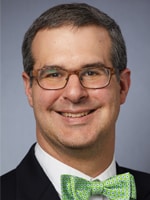Charna Albert
November 2022—In mid-October, flu was picking up, with high levels of activity in Texas, Georgia, the District of Columbia, South Carolina, Tennessee, and New York. Elsewhere, it was still on the lower side, with less known about what was to come but plans in place. And questions, too, about laboratory testing as it relates to SARS-CoV-2, “which is going to be a challenge,” says David Peaper, MD, PhD, D(ABMM), a member of the CAP Microbiology Committee.

Dr. Peaper
For example, how much testing do those who have respiratory virus symptoms but who test negative at home for SARS-CoV-2 need? Should schools require negative flu and respiratory syncytial virus test results in addition to a negative SARS-CoV-2 result in their COVID reentry protocols? What should workplaces require for an employee with respiratory virus symptoms but negative for SARS-CoV-2 with an at-home test? “There are questions around that that the laboratory may be asked to deal with, and a lot is going to depend on how different groups and institutions view the need to test for COVID and for other respiratory viruses,” says Dr. Peaper, associate professor of laboratory medicine, Yale School of Medicine, and director of the clinical microbiology laboratory, Yale New Haven Hospital.
Cases of rhinovirus had risen by mid-September. “The numbers aren’t huge compared to COVID or [a typical] flu season,” said Benjamin Pinsky, MD, PhD, “but certainly there’s a bump in the positivity rate.” The Centers for Disease Control and Prevention in September issued a health advisory about an increase in pediatric hospitalizations in patients with severe respiratory illness who also tested positive for rhinovirus and/or enterovirus, noted Dr. Pinsky, professor of pathology and of medicine (infectious diseases), Stanford University School of Medicine, and medical director of the clinical virology laboratory, Stanford Health Care and Stanford Children’s Health. Some are hypothesizing, Dr. Peaper says, that the lack of exposure to flu in recent years that could mean a more severe flu season could mean the same for rhinovirus in children—a more severe season. “If you take all of that together, which is a lot of unknowns, then you do have a theoretical possibility for a pretty bad flu season and a pretty bad respiratory virus season.” By mid-October, pediatric RSV case numbers had spiked in more than two dozen states. By Oct. 24, experts were predicting a rough season.

Dr. Pinsky
Information about the severity of disease in the Southern Hemisphere wasn’t yet available in early fall, but in a season with high numbers of influenza cases, which the Southern Hemisphere had, “you’re going to have more cases of severe flu,” Dr. Peaper says. “It’s at that point just a numbers game.” Another concern: “If we have a higher peak, or as we learned with COVID if the peak is very compressed, that’s going to put a lot of burden on the health care system and on laboratories to keep up with testing.” And for laboratories, “when we have a big peak or a severe season, then there’s a very long testing tail,” in which testing persists even after viral activity has declined. “It doesn’t necessarily turn on and off,” Dr. Peaper says. “Providers are still worried about flu, testing for flu. People still are concerned about it.”
Laboratories already have been testing many if not all admissions for SARS-CoV-2, Dr. Peaper says, “so adding on additional respiratory viruses may not be as complicated as it has been in the past.” But if schools and other institutions begin to require testing for the seasonal respiratory viruses, for example, that testing would fall to the laboratory.
One of Yale New Haven Hospital’s clinical ambulatory practice groups has implemented point-of-care PCR testing for SARS-CoV-2, flu, and RSV, as well as a point-of-care strep test. “So they are in a better position to do more testing and sensitive nucleic acid amplified testing in their offices,” Dr. Peaper says. Other groups may prefer not to see respiratory virus patients or patients with such symptoms in the office until they have tested negative for SARS-CoV-2. “So those groups may be sending us less testing.” But some areas or laboratories that still have organized specimen collection sites for SARS-CoV-2 may do the same for influenza and RSV. “So we could see some influx of testing in that way.”
“The past few years have been interesting,” he says. “I don’t see how this one will be any different.”
In spring 2020, Yale New Haven Hospital formed a cross-institutional COVID testing stewardship group that included university, hospital, and ambulatory group representatives. Its central purpose was to formulate a SARS-CoV-2 testing strategy, says Dr. Peaper, who co-chairs the group. “And now that has broadened to include the [seasonal] respiratory virus testing strategy, as well as the guidance and priorities within our testing populations about who should get what test and when.” They look at testing trends, positivity rates, supply chain, the testing that’s available across the system, and more, and they work closely with IT teams on the electronic health record order streams.
“Streamlined pathways were developed for COVID, and whether those pathways should be used for other respiratory viruses is what’s being discussed now,” he says.
 CAP TODAY Pathology/Laboratory Medicine/Laboratory Management
CAP TODAY Pathology/Laboratory Medicine/Laboratory Management
